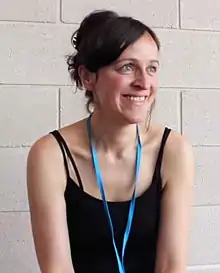Irene Miguel-Aliaga
Irene Miguel-Aliaga FRS FMedSci is a Spanish-British physiologist who is Professor of Genetics and Physiology at Imperial College London.[2] Her research investigates the plasticity of adult organs, and why certain organs change shape in response to environmental changes.[3][4][5] She was elected Fellow of the Royal Society in 2022.
Irene Miguel-Aliaga | |
|---|---|
 Miguel-Aliaga in 2015 | |
| Alma mater | University of Oxford (DPhil) |
| Awards | EMBO Member (2017) Suffrage Science award (2018) |
| Scientific career | |
| Institutions | Imperial College London National Institute for Medical Research University of Cambridge Harvard University Linköping University |
| Thesis | Spinal muscular atrophy : of flies, worms and men (2000) |
| Doctoral advisor | Kay Davies[1] |
| Website | www |
Early life and education
Miguel-Aliaga is from Spain and grew up in Barcelona.[4] She completed her Doctor of Philosophy degree at the University of Oxford,[1] supervised by Kay Davies on invertebrate models of human diseases.[3][4]
Research and career
After her PhD, she moved to the United States for postdoctoral research, joining the laboratory of Stefan Thor at Harvard University. Miguel-Aliaga then moved to Linköping University, where she characterised the neurons of Drosophila.[3] She was awarded a Marie Skłodowska-Curie Actions fellowship and joined Alex Gould at the National Institute for Medical Research, where she studied the specification of gut-innervating insulin-producing neurons.[3] In 2008, Miguel-Aliaga started her independent research career at the University of Cambridge. She was named a Wellcome Trust Career Development Fellow, and eventually moved to Imperial College London.[3] At Imperial, Miguel-Aliaga serves as Professor of Genetics and Physiology.[3]
Miguel-Aliaga's research investigates the plasticity of human organs, and in particular, how fully developed adult organs are impacted by environmental changes.[6] To understand these processes, Miguel-Aliaga makes use of the gastrointestinal tract,[7] as it allows for the study of how an organ senses signals from its internal and external environments.[6] To better understand the functional significance of various organs, Miguel-Aliaga compared the intestinal epithelium of males and females. She identified that different biological sexes demonstrate different brain-gut communications, particularly during production and tumour formation.[8] As part of this work, her group identified the communication pathways that exist between the gastrointestinal tract and other organs. She has continued to use the model organism Drosophila, as it shares over 60% of its genes with humans.[8]
Awards and honours
- 2012 European Molecular Biology Organization young investigator
- 2015 Journal of Cell Science One to Watch[9]
- 2017 Elected a member of the European Molecular Biology Organization (EMBO)[10]
- 2018 European Research Council advanced grant
- 2018 Suffrage Science Women In Science Award
- 2019 Elected a Fellow the Academy of Medical Sciences (FMedSci)[11]
- 2022 Elected a Fellow of the Royal Society (FRS)[12][8]
- 2022 Mary Lyon Medal[13]
References
- Miguel-Aliaga, Irene (2000). Spinal muscular atrophy : of flies, worms and men. ox.ac.uk (DPhil thesis). University of Oxford. OCLC 59391590. EThOS uk.bl.ethos.343478.
- Irene Miguel-Aliaga publications from Europe PubMed Central
- www
.imperial .ac .uk /people /i .miguel-aliaga - Katherine Brown (11 June 2020). "An interview with Irene Miguel-Aliaga". Development. 147 (11). doi:10.1242/DEV.191650. ISSN 0950-1991. PMID 32527934. Wikidata Q96302266.
- "Miguel-Aliaga Lab: Gut Signalling and Metabolism". miguelaliagalab.com.
- Good, Web Made. "Research". Miguel-Aliaga Lab. Retrieved 2022-05-10.
- "Gut Signalling and Metabolism Research Group | Irene Miguel-Aliaga". mrc.ac.uk. LMS London Institute of Medical Sciences. Retrieved 2022-05-10.
- "LMS Scientist Irene Miguel-Aliaga elected a Fellow of the Royal Society". LMS London Institute of Medical Sciences. 2022-05-10. Retrieved 2022-05-10.
- Irene Miguel-Aliaga; Anna Bobrowska (1 October 2015). "Cell scientist to watch--Irene Miguel-Aliaga". Journal of Cell Science. 128 (19): 3519–3520. doi:10.1242/JCS.178962. ISSN 0021-9533. Wikidata Q47995006.
- "Find people in the EMBO Communities".
- "Professor Irene Miguel-Aliaga". acmedsci.ac.uk. Academy of Medical Sciences. Retrieved 2022-05-10.
- Anon (2022). "Irene Miguel-Aliaga". royalsociety.org. Royal Society. Retrieved 2022-05-10.
- "Mary Lyon Medal 2022 - Prof Irene Miguel-Aliaga". Genetics Society. Retrieved 2022-05-10.
- Paola Cognigni; Andrew P Bailey; Irene Miguel-Aliaga (1 January 2011). "Enteric neurons and systemic signals couple nutritional and reproductive status with intestinal homeostasis". Cell Metabolism. 13 (1): 92–104. doi:10.1016/J.CMET.2010.12.010. ISSN 1550-4131. PMC 3038267. PMID 21195352. Wikidata Q34571057.
- Bruno Lemaitre; Irene Miguel-Aliaga (1 January 2013). "The digestive tract of Drosophila melanogaster". Annual Review of Genetics. 47: 377–404. doi:10.1146/ANNUREV-GENET-111212-133343. ISSN 0066-4197. PMID 24016187. Wikidata Q38135489.